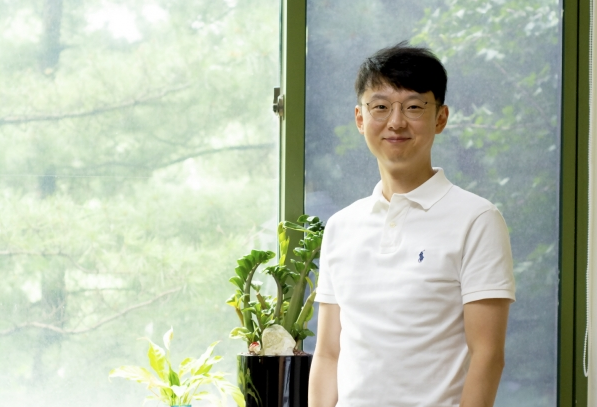-
From medical school to structural biologist / Bioengineering Professor Chung JeongminAuthor : 관리자Date : 2022.09.15Hit : 389
-

What if you went to the hospital for simple wound treatment and suddenly became critically ill? It may sound like hard to believe, but it is something that can possibly happen in our daily life. However, the place must be limited to a "hospital." Transformation from a simple wound treatment to a critically ill patient fighting for life is something only bacterial pathogens can do. It seems that the solution will be found only by looking into every insides of this super bacterium, which is resistant to antibiotics and difficult to catch with current medical technology.
From medical school to structural biologist
Professor Chung Jeongmin's research background as a structural biologist in medical school is quite unusual. First of all, he is a foreigner, not a Korean, who went to New Zealand when he was in middle school and attended middle school, high school, college, and graduate school in New Zealand. He was admitted to a medical school, but the electron microscope he encountered in his third year changed his life. "Being able to see proteins with my own eyes, which I had only seen in pictures in textbooks, was like a revolution. That's when I decided to become a structural biologist." He went back to medical school and started all over again. After earning a degree, he worked at the Basic Science Support Research Institute. When a senior researcher was appointed as a university professor, he entered his research group and studied again to obtain a doctorate. Then, while working as a postdoctoral fellow at the University of Michigan, USA, he published an influential research paper. He has published more than 20 journals and 1 patent, including papers of top 5% JCR. The center of all his research is the "electron microscope." Through the radical development of the field of cryo-electron microscopy, which produced the 2017 Nobel Prize in Chemistry, he uses an electron microscope while deriving high-resolution 3-dimensional images of biomolecules. The value is increasing even more, and it is now possible to study the mechanism of action of biomolecules that were unknown until now. Professor Chung Jeongmin has been researching viruses and infectious disease-causing pathogens (bacteria) for over ten years. He is particularly interested in membrane proteins of pathogens and is conducting research using cryogenic electron microscopy. He has published many papers, including SCI review papers on cryogenic electron microscope image analysis methods, and is attracting attention as a young researcher in related fields.
"I want to be recognized for identifying the bacterial membrane protein secretion system"
Membrane protein complexes have very complex structures and are difficult to separate and purify, making them challenging to study. The main disease-related proteins of super bacteria are especially membrane proteins, so the development of the treatment is challenging. In the case of his major research target pathogens, they are receiving worldwide attention enough to be selected and studied by the US Centers for Disease Control and Prevention as the TOP 5 endangered pathogens. "The structure of a protein can be said to be its function. In particular, the secretion mechanism of membrane proteins is quite complex, so high-resolution 3D structure reconstruction is very important for functional research. And I want to produce good 3D images using cryo-EM better than anyone else. Of course, deriving is the beginning of the research, so subsequent research should be conducted in more depth, but my first research goal is to make the process as short as possible until deriving the structure." That is why he is planning to use artificial intelligence. A computer is essential to convert the information obtained from an electron microscope into a three-dimensional image. Until now, people directly participated in the programming work, which consumed a lot of time and effort. Professor Chung's idea is to use artificial intelligence deep learning to reduce the process in the future. "If we reduce the time and effort required to obtain a 3D image, we will be able to focus more on research to uncover the mechanism of action of infectious bacteria and viruses afterward," he said. He also revealed his expectations for an innovative new drug development platform. "Rather than being the first to do so, I would like to do research that reminds Professor Chung Jeongmin when it comes to cryogenic electron microscopy and bacterial membrane protein secretion systems."
He is delightfully dealing with the difficulties of working as a Korean researcher and the complicated research with his unique personality. He is trying to create a pleasant research atmosphere for students as well. (Photo by Journalist Lim Sunghee)
“I am grateful to the school and fellow professors”
Since he spent most of his life overseas, he does not have many connections in Korea. Contrary to concerns that he would be lonely, the warm touch and support from fellow researchers and professors in the department gave him great strength. “I am very grateful to everyone for taking good care of me. The Department of Biotechnology is one of the ACE departments of the Catholic University of Korea, and the school's active support also creates a good environment for me to focus on research. I think I have a lot of good people around me,” said Professor Chung with a smile. The professor, who led a pleasant atmosphere throughout the interview, also strives to create a pleasant research environment for students. His research is very complicated since it's about making the things we cannot see visible to our eyes in 3D. Could Professor Chung's delightfulness be a shortcut to solving challenging problems?
-
Attachment File

